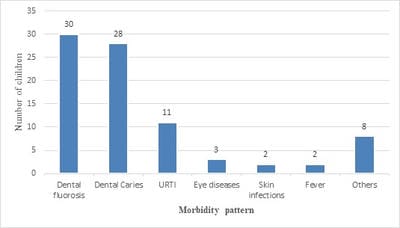Prevalence and pattern of morbidities among children at a private school in rural area of Koppal, Karnataka
M Nimbannavar S.1, Mane V.2*, Yuvaraj B Y.3
DOI: https://doi.org/10.17511/ijphr.2017.i2.04
1 Smita M Nimbannavar, Assistant Professor, Department of Community Medicine, Koppal Institute of Medical Sciences, Koppal, Karnataka, India.
2* Vijaykumar Mane, Assistant Professor, Department of Community Medicine, Koppal Institute of Medical Sciences, Koppal, Karnataka, India.
3 Yuvaraj B Y, Professor & Head, Department of Community Medicine, Koppal Institute of Medical Sciences, Koppal, Karnataka, India.
Introduction: Children are the most valued resources and their health is the biggest investment for any country in the world. Morbidity rates among school children in our country are among the highest in the world and are the common causes of low school enrolment, high absenteeism, early dropout and poor classroom performance. Frequent and regular health check-ups are considered as an ideal platform for earlier detection and prompt treatment of the health problems among them. Objective: To study the prevalence and pattern of morbidities among Primary school children in the study setting. Methods: A cross sectional study was conducted among school children at a Private Primary school situated in the Katharki village, a rural area of Koppal. A pretested and semi structured questionnaire was used for data collection and analyzed using Epiinfo software version 3.5.4. Results: The prevalence of morbidity was found to be among 79 (44.63%) of children and the most common morbidities were Dental Fluorosis and Dental caries followed by Upper respiratory tract infections. Morbidity was marginally higher among male children and was found to be directly proportional to the age group of the children in our study. Conclusion: There is a need to focus on the regular health check-up of school children to improve their health status so that they can attain their full potential and become productive citizens of the country.
Keywords: Morbidity pattern, Prevalence, School child
| Corresponding Author | How to Cite this Article | To Browse |
|---|---|---|
| , Assistant Professor, Department of Community Medicine, Koppal Institute of Medical Sciences, Koppal, Karnataka, India. Email: |
Nimbannavar SM, Mane V, Yuvaraj B Y. Prevalence and pattern of morbidities among children at a private school in rural area of Koppal, Karnataka. Public Health Rev Int J Public Health Res. 2017;4(2):53-58. Available From https://publichealth.medresearch.in/index.php/ijphr/article/view/62 |


 ©
© 